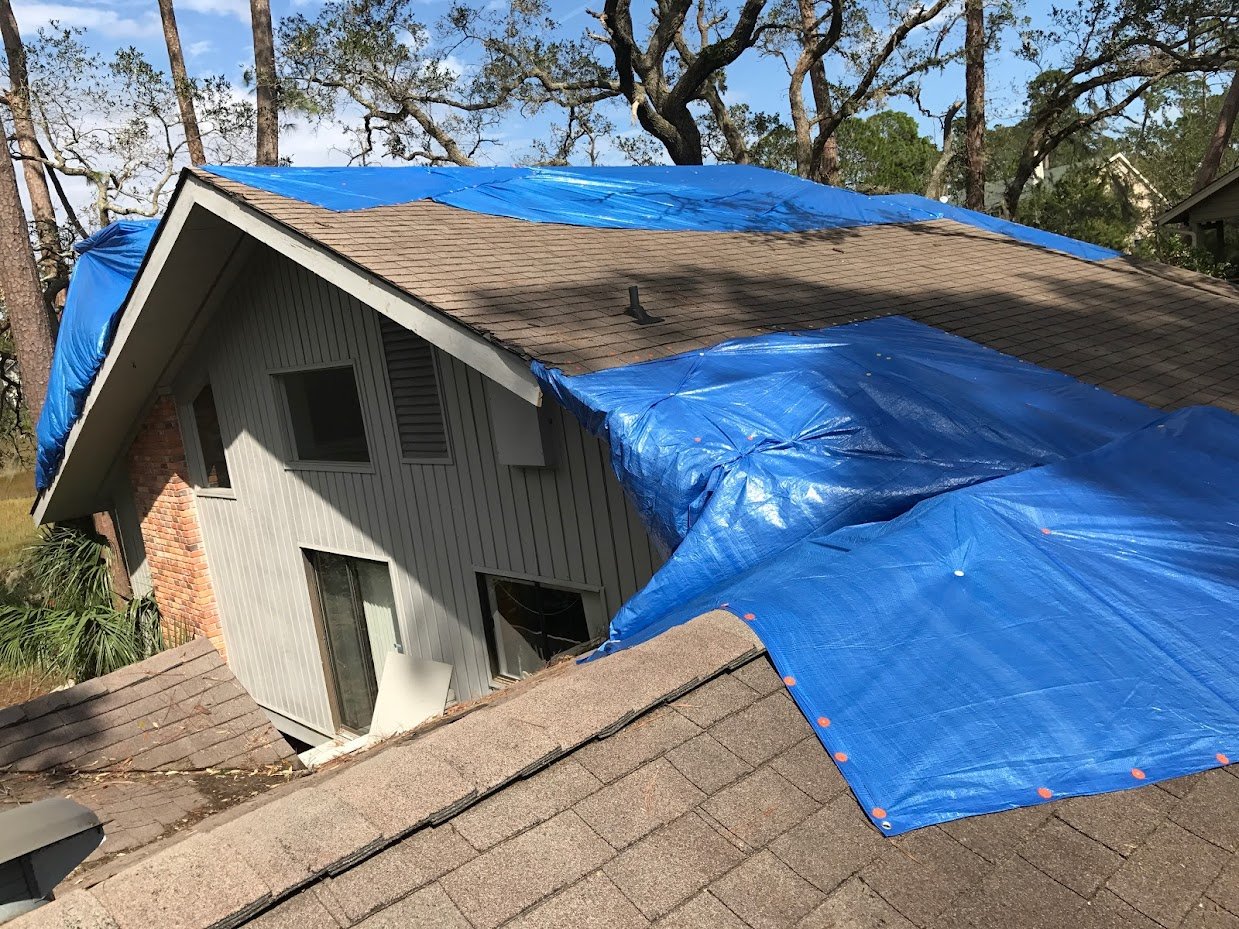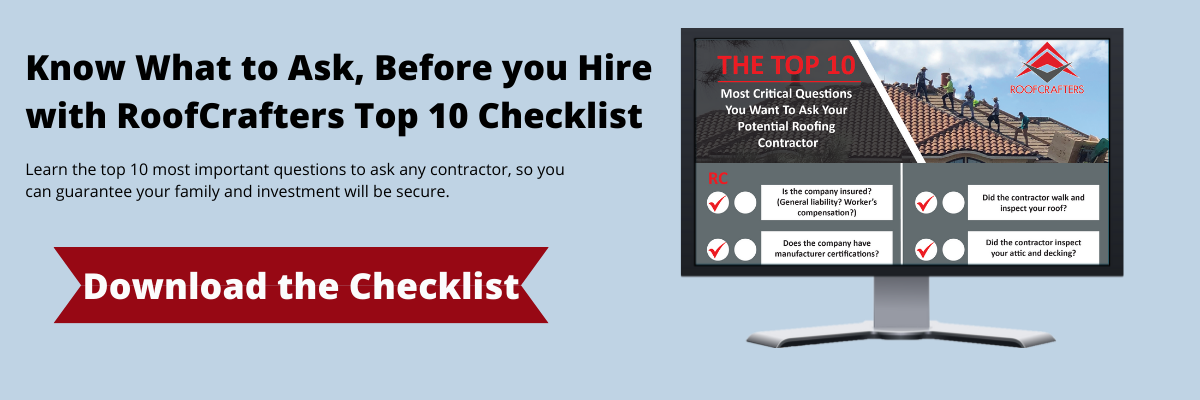
When hurricanes or straight-line storms roll in, the risk of catastrophic roof damage skyrockets. With wind speeds topping 150 mph, even the sturdiest roofs can face damage. Now, I’m not saying your roof will get ripped clean off, but let’s be real, flying debris, damaged shingles, and even structural issues can become a serious concern. So, what’s your game plan if this happens?
At RoofCrafters, we’ve been helping homeowners repair and replace storm-damaged roofs for nearly 30 years, and here’s the deal: knowledge is power. Knowing what to do after the storm clears can save you time, stress, and money. One critical step? Roof tarping.
If your roof takes a hit, it’s not just about missing shingles, it’s about preventing water damage, protecting your belongings, and keeping mold and mildew at bay. Whether you’re preparing for the storm or dealing with the aftermath, you’ve come to the right place. In this article, we’ll break down everything you need to know about roof tarping, including costs, DIY tips, and when to call in the pros. Let’s dive in!
DIY Roof Tarping: Costs and Materials Breakdown
Let’s be honest: Most roofing companies don’t recommend DIY fixes. But in an emergency, sometimes you’ve got to take matters into your own hands. Done correctly, DIY tarping can save you money. Done incorrectly? It could lead to more damage (and higher costs) down the line.
Here’s the good news: if you’re patching a small area, it’s relatively affordable. Covering a few holes might cost you less than $100 in materials. Need to tarp your entire roof? For an average 1,500-square-foot home, expect to spend $150–$350 on a tarp from your local hardware store.
Pro tip: Only attempt this if you’re confident in your ability to stay safe and avoid further roof damage. If you’re unsure, calling a professional is the way to go.
Key Factors Influencing the Cost of Roof Tarping

So, what variables affect the cost of professional roof tarping? What are the key factors in the costs? There are a few different components that influence the final price, including:
- Material costs
- Hourly rate
- Damage assessment
- Emergency vs. standard service
- Roof accessibility
Material Costs: Understanding the Impact on Tarping Expenses
The materials themselves affect the cost of your roof tarping service, although prices will vary from company to company, as well as region to region. The size of your roof or the damage itself plays a large role in the cost of materials, too.
Xactimate allows for 1.33 square feet for tarping using nails, 3.17 per foot using sandbags, and if tarped during emergency service hours, it’s 1.85 per foot additional. Most insurance policies allow for up to 1% of the total policy for temporary repairs. So, for a $300,000 policy, your roofing company can only recover $3,000 for tarping and emergency repairs.
Hourly Rates and Roof Tarping: What to Expect
Standard hourly rates will vary depending on the city you live in and the average cost of living. If you’re able to, contact your local roofing companies and compare their prices, as well as how many hours they believe it will take to complete the job. The costs will vary, but remember that cheaper prices don’t always equal quality work.
Damage Assessment: The Role of Size and Cause in Tarping Costs
The reason and the size of the damage are quite frankly the most important considerations for the final tarping costs. In the case of a hurricane, if you have lightning damage or electrical burns, these areas need to be removed before tarping can even occur. If a tree strikes your roof during the storm, additional costs will be factored into removing the tree.
That being said, if the damage is small or large, the cost will vary vastly. If you’re tarping a small area post-storm, the price will be less. If your roof has sustained major damage and the weather is still questionable, it will ultimately come down to the square footage of the damaged area.
Emergency vs. Standard Tarping Services: Cost Differences
Standard rates vs. emergency service rates are another important factor to take into consideration. If you decide to get your roof tarped during normal business hours, your costs will be considerably less than if you need an emergency service. Typically, emergency service work is paid for by 1.5X the company's standard hourly rate.
Roof Accessibility: How It Influences Tarping Pricing
-thumb.jpeg?width=450&height=253&name=Kyle%20Revisions%204%20(1)-thumb.jpeg)
The last component that’s taken into consideration is the accessibility of your roof. How easy it is to climb and walk on your roof. Do you live in a single-story home with a slightly slanted roof? Or do you have 3 stories with a steep roof?
The prices will vary depending on the pitch of your roof. If your roof is less steep, it will take less time to tarp the area. If the pitch is steeper, it will take more time to tarp your roof because the crew needs to take their safety into account. The last component that's taken into consideration is the accessibility of your roof.
The Importance of Roof Tarping: When and Why to Consider It
If you’re concerned your roof will sustain minor or major roof damage during a hurricane or severe weather event, it’s incredibly important that you reach out to your local roofing contractor as soon as possible. Whether your roof is tarped during standard or emergency hours, the most important thing is making sure your family and your belongings remain safe and secure.
If you’re struggling to find the best contractor for the job, be sure to download “The Top 10 Most Critical Questions You Want to Ask Your Potential Roofing Contractor”. This checklist includes several different prompts to ask your roofer to prepare you to hold the company accountable for its quality of work and services when it comes to tarping your roof.
In the meantime, stay safe and remain diligent. Heed any evacuation warnings, and take care of yourself and your family. Hurricanes are frightening, and the thought of losing your home and precious belongings is harrowing. However, your safety is more important than any material item. Take care of your well-being, and rest assured that RoofCrafters will do everything in our power to aid you in hurricane relief efforts should your roof sustain damage of any kind.
My name is Kevin Mills, and I am the lead estimator for RoofCrafters’ Tampa division. I’m originally from Michigan, and I enjoy hunting, fishing, and spending any free time outdoors. What I’m most passionate about, though, is helping business owners and homeowners alike achieve their roofing goals, all while providing a seamless customer journey.




